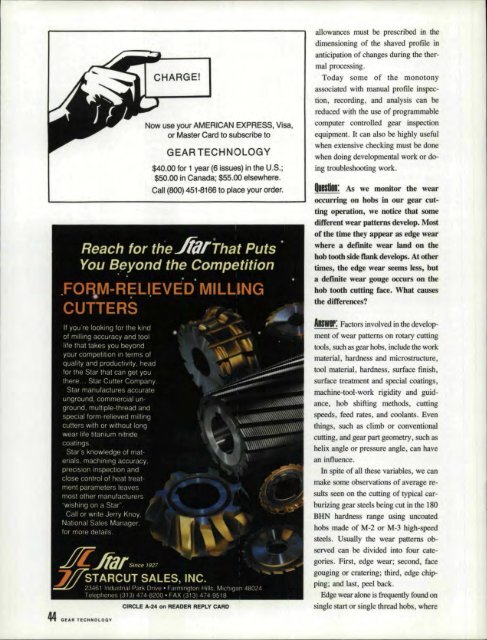Download PDF - Gear Technology magazine
Download PDF - Gear Technology magazine
Download PDF - Gear Technology magazine
Create successful ePaper yourself
Turn your PDF publications into a flip-book with our unique Google optimized e-Paper software.
___________________________ ....... ,1 oocurring<br />
Now use your A'MER!ICAN EXPRESS,<br />
or 'Master Card to subscribe to<br />
GEAIRTECHNOLOGY<br />
$40.00 for 1 year (6:issues) in the U.S.;<br />
$50.00 ln Canada; $55.00 ·elsewhere.<br />
Call (800) 451·8,166 to place your order.<br />
Visa,<br />
allowances must be prescribed in the<br />
dimensioning of the shaved profile in<br />
anticipation of changes during the thermal<br />
processing.<br />
Today some of the monotony<br />
associated with manual profile inspection,<br />
recording, and analysis can be<br />
reduced with the use of programmable<br />
computer controlled gear inspection<br />
equipment. It can. also be highly useful<br />
when extensive checking must be done<br />
when doing developmental work: or doing<br />
troubleshooting work.<br />
Oueadon: As we monitor the wear<br />
on hobs in our gear cutting<br />
operation, we notice that some<br />
different wear patterns develop. Most<br />
of the time they .appear as edge wear<br />
where a definite wear land on the<br />
hob tooth. side Rank. develops. At otber<br />
times, the edge wear seems less, but.<br />
a defmite wear gouge oocurs on the<br />
hob tooth cutting face. What causes.<br />
the differeooes·?<br />
CIRCLE ,6,·24 en READER REPLY CA'RO<br />
AIls!'..; Factors involved in the development<br />
of wearpeuems on rotary cutting<br />
tools, such as gear hobs, include the work<br />
material, hardnessand microstructure,<br />
tool material. hardness, surface 6JJish,<br />
surface treatment and special coatings,<br />
machine-tool-work rigidity and guidance,<br />
hob shifting methods, cutting<br />
speeds, feed rates, and eoolants. Even<br />
things, such as climb or conventional.<br />
cutting, and gear part geometry, such as<br />
helix angle or pressure angle, can have<br />
an influence.<br />
In spite of all these variables, we can<br />
make some observations of average resnits<br />
seen on the cutting of typical carburizing<br />
gear steels being cut in the 180<br />
BHN hardness range using uncoated<br />
bobs made of M-2 or M-3 high-speed<br />
steels. Usually the wear patterns observed<br />
can be divided into four categories.<br />
First, edge wear; second, face<br />
gouging or cratering: third, edge chipping;<br />
and last, peel back.<br />
Edge wear alone is frequently found on<br />
single stan or singlethread hobs, where
















